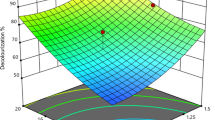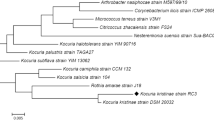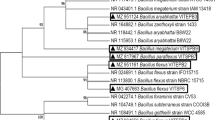Abstract
The issue of unhealthy rivers in Malaysia has become a grave concern in the recent years due to the release of improperly treated industrial wastewater particularly from the textile plants. The present study capitalized on Rhodococcus strain UCC 0010 as a sustainable approach supporting eco-friendly and cost-effective measures to detoxify Congo red, a commonly found toxic diazo dye in textile finishing. Response surface methodology showed interaction effect between significant parameters was present where almost 100% decolourization at pH 2.8, 0.75% (v/v) carbon source and 35 °C was observed after 4 h of incubation. This strategy was able to reduce the incubation time by 83% and improved the decolourizing activity by 18% compared to conventional optimization method. This study revealed that the occurrence of Congo red decolourization was indeed mediated by Rhodococcus strain UCC 0010 and this strain used coconut waste as substrate for growth which was more economical than the commonly used yeast extract. The discovery of optimized decolourization at highly acidic condition and the occurrence of high titre of concentrated intracellular laccase activity (103.75 U/mg) suggested the presence of novel rhodococcal laccase which was able to decolourize 99% 0.2 g/L Congo red. Furthermore, phytotoxicity study observed that almost 100% germination of Vigna radiata and Vigna unguiculata occurred in treated Congo red solution indicating the ability of the strain to detoxify the dye. Collectively, these findings provided the platform to further improvise the function of the biocatalyst for viable application in treating textile wastewater.
Graphic abstract




source concentration (g/L) towards Congo red decolourization

source concentration (g/L) towards Congo red decolourization

Similar content being viewed by others
References
Asses N, Ayed L, Hkiri N, Hamdi M (2018) Congo red decolorization and detoxification by Aspergillus niger: Removal mechanisms and dye degradation pathway. Biomed Res Int 2018:3049686. https://doi.org/10.1155/2018/3049686
Bakar NA, Othman N, Yunus ZM, Daud Z, Norisman NS, Hisham MH (2020) Physico-chemical water quality parameters analysis on textile. In: IOP conference series: earth and environmental science. United Kingdom, Bristol, p 012077
Bhatia D, Sharma NR, Singh J, Kanwar RS (2017) Biological methods for textile dye removal from wastewater: a review. Crit Rev Environ Sci Technol 47(19):1836–1876. https://doi.org/10.1080/10643389.2017.1393263
Birgani PM, Ranjbar N, Abdullah RC, Wong KT, Lee G et al (2016) An efficient and economical treatment for batik textile wastewater containing high levels of silicate and organic pollutants using a sequential process of acidification, magnesium oxide and palm shell-based activated carbon application. J Environ Manage 184:229–239. https://doi.org/10.1016/j.jenvman.2016.09.066
Chakraborty S, Basak B, Dutta S, Bhunia B, Dey A (2013) Decolorization and biodegradation of Congo red dye by a novel white rot fungus Alternaria alternata CMERI F6. Bioresour Technol 147:662–666. https://doi.org/10.1016/j.biortech.2013.08.117
Chauhan PS, Goradia B, Saxena A (2017) Bacterial laccase: recent update on production, properties and industrial applications. 3 Biotech 7(5):323. https://doi.org/10.1007/s13205-017-0955-7
Cui D, Li G, Zhao M, Han S (2014) Decolourization of azo dyes by a newly isolated Klebsiella sp. strain Y3, and effects of various factors on biodegradation. Biotechnol Biotechnol Equip 28(3):478–486. https://doi.org/10.1080/13102818.2014.926053
D’Souza E, Fulke AB, Mulani N, Ram A, Asodekar M, Narkhede N, Gajbhiye SN (2017) Decolorization of Congo red mediated by marine Alcaligenes species isolated from Indian West coast sediments. Environ Earth Sci 76(20):721. https://doi.org/10.1007/s12665-017-7077-8
Das A, Bhattacharya S, Panchanan G, Navya BS, Nambiar P (2016) Production, characterization and Congo red dye decolourizing efficiency of a laccase from Pleurotus ostreatus MTCC 142 cultivated on co-substrates of paddy straw and corn husk. J Genet Eng Biotechnol 14(2):281–288. https://doi.org/10.1016/j.jgeb.2016.09.007
Falade AO, Eyisi OA, Mabinya LV, Nwodo UU, Okoh AI (2017) Peroxidase production and ligninolytic potentials of fresh water bacteria Raoultella ornithinolytica and Ensifer adhaerens. Biotechnol Rep 16:12–17. https://doi.org/10.1016/j.btre.2017.10.001
Gomaa EZ (2016) Biodegradation and detoxification of azo dyes by some bacterial strains. Microbiol J 6(1–2):15–24
Gonzalez-Coronel LA, Cobas M, Rostro-Alanis MDJ, Parra-Saldívar R, Hernandez Luna C, Pazos M, Sanromán MÁ (2017) Immobilization of laccase of Pycnoporus sanguineus CS43. N Biotechnol 39:141–149. https://doi.org/10.1016/j.nbt.2016.12.003
Hamad MT, Soliman MS (2020) Application of immobilized Aspergillus niger in alginate for decolourization of Congo red dye by using kinetics studies. J Polym Environ 28(12):3164–3180. https://doi.org/10.1007/s10924-020-01838-0
Hanis KKA, Nasri AM, Farahiyah WW, Rabani MM (2020) Bacterial degradation of azo dye Congo red by Bacillus sp. In: Journal of physics: conference series. Bristol, United Kingdom, p 022048
Haque MM, Haque MA, Mosharaf MK, Marcus PK (2020) Novel bacterial biofilm consortia that degrade and detoxify the carcinogenic diazo dye Congo red. Arch Microbiol. https://doi.org/10.1007/s00203-020-02044-1
Hasdianty A, Suhaila YN, Hazwan AH, Maniyam MN, Fadzli AM, Ibrahim AL (2020) Inferring the evolutionary relationship of 23 Malaysian Rhodococcus isolates with potential as cholesterol degrading bacteria. Biocatal Agric Biotechnol 30:101840. https://doi.org/10.1016/j.bcab.2020.101840
Kiran S, Adeel S, Nosheen S, Hassan A, Usman M, Rafique MA (2017) Recent trends in textile effluent treatments: a review. Adv Mater Wastewater Treat 29:29–49. https://doi.org/10.1002/9781119407805
Kuyukina MS, Ivshina IB (2019) Bioremediation of contaminated environments using Rhodococcus. Biology of Rhodococcus. Springer, Cham, pp 231–270
Lade H, Govindwar S, Paul D (2015) Low-cost biodegradation and detoxification of textile azo dye CI reactive blue 172 by Providencia rettgeri strain HSL1. J Chem 2015:1–10. https://doi.org/10.1155/2015/894109
Madhav S, Ahamad A, Singh P, Mishra PK (2018) A review of textile industry: wet processing, environmental impacts, and effluent treatment methods. Environ Qual Manag 27(3):31–41. https://doi.org/10.1002/tqem.21538
Mahmood S, Khalid A, Arshad M, Mahmood T, Crowley DE (2016) Detoxification of azo dyes by bacterial oxidoreductase enzymes. Crit Rev Biotechnol 36(4):639–651. https://doi.org/10.3109/07388551.2015.1004518
Maniyam MN, Hari M, Yaacob NS (2020a) Enhanced methylene blue decolourization by Rhodococcus strain UCC 0003 grown in banana peel agricultural waste through response surface methodology. Biocatal Agric Biotechnol 23:101486. https://doi.org/10.1016/j.bcab.2019.101486
Maniyam MN, Ibrahim AL, Cass AE (2020b) Decolourization and biodegradation of azo dye methyl red by Rhodococcus strain UCC 0016. Environ Technol 41(1):71–85. https://doi.org/10.1080/09593330.2018.1491634
Maniyam MN, Yaacob NS, Azman HH, Ab Ghaffar NA, Abdullah H (2018) Immobilized cells of Rhodococcus strain UCC 0004 as source of green biocatalyst for decolourization and biodegradation of methyl orange. Biocatal Agric Biotechnol 16:569–578. https://doi.org/10.1016/j.bcab.2018.10.008
Mnif I, Fendri R, Ghribi D (2015) Biosorption of Congo red from aqueous solution by Bacillus weihenstephanensis RI12; Effect of SPB1 biosurfactant addition on biodecolorization potency. Water Sci Technol 72(6):865–874. https://doi.org/10.2166/wst.2015.288
Molina-Ramírez C, Castro M, Osorio M, Torres-Taborda M, Gómez B et al (2017) Effect of different carbon sources on bacterial nanocellulose production and structure using the low pH resistant strain Komagataeibacter medellinensis. Materials 10(6):639. https://doi.org/10.3390/ma10060639
Neifar M, Chouchane H, Mahjoubi M, Jaouani A, Cherif A (2016) Pseudomonas extremorientalis BU118: a new salt-tolerant laccase-secreting bacterium with biotechnological potential in textile azo dye decolourization. 3 Biotech 6(1):107. https://doi.org/10.1007/s13205-016-0425-7
Niederstebruch N, Sixt D, Benda BI, Banboye N (2017) A suitable blood agar containing human blood especially for the use in laboratories of developing countries. J Infect Dev Ctries 11(05):399–406. https://doi.org/10.3855/jidc.8957
Ning XA, Yang C, Wang Y, Yang Z, Wang J, Li R (2014) Decolorization and biodegradation of the azo dye Congo red by an isolated Acinetobacter baumannii YNWH 226. Biotechnol Bioprocess Eng 19(4):687–695. https://doi.org/10.1007/s12257-013-0729-y
Sadeghian I, Rezaie Z, Rahmatabadi SS, Hemmati S (2020) Biochemical insights into a novel thermo/organo tolerant bilirubin oxidase from Thermosediminibacter oceani and its application in dye decolorization. Process Biochem 88:38–50. https://doi.org/10.1016/j.procbio.2019.09.030
Sarkar S, Banerjee A, Halder U, Biswas R, Bandopadhyay R (2017) Degradation of synthetic azo dyes of textile industry: a sustainable approach using microbial enzymes. Water Conserv Sci Eng 2(4):121–131. https://doi.org/10.1007/s41101-017-0031-5
Schmidt C, Berghahn E, Ilha V, Granada CE (2019) Biodegradation potential of Citrobacter cultures for the removal of Amaranth and Congo red azo dyes. Int J Environ Sci Technol 16(11):6863–6872. https://doi.org/10.1007/s13762-019-02274-x
Senthilkumar S, Prabhu HJ, Perumalsamy M (2013) Response surface optimization for biodegradation of textile azo dyes using isolated bacterial strain Pseudomonas sp. Arab J Sci Eng 38(9):2279–2291. https://doi.org/10.1007/s13369-012-0507-8
Sundarajoo A, Maniyam MN (2019) Enhanced decolourization of Congo red dye by Malaysian Rhodococcus UCC 0010 immobilized in calcium alginate. J Adv Res Design 63(1):11–17
Sundararaman S, Narendrakumar G (2019) Stabilization of bacterial cells culture on immobilized alginate beads and optimization of Congo red decolorization. Indian J Chem Technol 26(6):544–552
Talha MA, Goswami M, Giri BS, Sharma A, Rai BN, Singh RS (2018) Bioremediation of Congo red dye in immobilized batch and continuous packed bed bioreactor by Brevibacillus parabrevis using coconut shell bio-char. Bioresour Technol 252:37–43. https://doi.org/10.1016/j.biortech.2017.12.081
Tokiran S, Maniyam MN, Yaacob NS, Ibrahim AL (2016) Decolourization of textile dyes by Malaysian Rhodococcus strains. Indian J Fundam Appl Life Sci 6:14–20
Váradi L, Luo JL, Hibbs DE, Perry JD, Anderson RJ, Orenga S, Groundwater PW (2017) Methods for the detection and identification of pathogenic bacteria: past, present, and future. Chem Soc Rev 46(16):4818–4832. https://doi.org/10.1039/C6CS00693K
Velkova ZY, Kirova GK, Stoytcheva MS, Gochev V (2018) Biosorption of Congo red and methylene blue by pretreated waste Streptomyces fradiae biomass—equilibrium, kinetic and thermodynamic studies. J Serbian Chem Soc 83(1):107–120. https://doi.org/10.2298/JSCI70519093V
Vikrant K, Giri BS, Raza N, Roy K, Kim KH, Rai BN, Singh RS (2018) Recent advancements in bioremediation of dye: current status and challenges. Bioresour Technol 253:355–367. https://doi.org/10.1016/j.biortech.2018.01.029
Vyavahare GD, Gurav RG, Jadhav PP, Patil RR, Aware CB, Jadhav JP (2018) Response surface methodology optimization for sorption of malachite green dye on sugarcane bagasse biochar and evaluating the residual dye for phyto and cytogenotoxicity. Chemosphere 194:306–315. https://doi.org/10.1016/j.chemosphere.2017.11.180
Wang N, Chu Y, Zhao Z, Xu X (2017) Decolorization and degradation of Congo red by a newly isolated white rot fungus, Ceriporia lacerata, from decayed mulberry branches. Int Biodeterior Biodegradation 117:236–244. https://doi.org/10.1016/j.ibiod.2016.12.015
Wong S, Yac’cob NAN, Ngadi N, Hassan O, Inuwa IM (2018) From pollutant to solution of wastewater pollution: Synthesis of activated carbon from textile sludge for dye adsorption. Chin J Chem Eng 26(4):870–878. https://doi.org/10.1016/j.cjche.2017.07.015
Yaseen DA, Scholz M (2019) Impact of pH on the treatment of artificial textile wastewater containing azo dyes using pond systems. Int J Environ Res 13(2):367–385. https://doi.org/10.1007/s41742-019-00180-1
Yusuf M, Khan MA, Otero M, Abdullah EC, Hosomi M, Terada A, Riya S (2017) Synthesis of CTAB intercalated graphene and its application for the adsorption of AR265 and AO7 dyes from water. J Colloid Interface Sci 493:51–61. https://doi.org/10.1016/j.jcis.2017.01.015
Zho Q, Ding L, Zhu Y, Zhong M, Yang C (2020) Process parameters optimization of gallic acid removal from water by MIEX resin based on response surface methodology. Processes 8(3):273. https://doi.org/10.3390/pr8030273
Acknowledgements
The funds to carry out this research was provided by the Selangor State Government and Universiti Selangor (Unisel) under the Geran Penyelidikan Negeri Selangor (GPNS/01-Unisel/18-002).
Author information
Authors and Affiliations
Contributions
AS was involved in formal analysis, investigation, writing—original draft and writing—review & editing. MNM was involved in conceptualization, methodology, validation, formal analysis, resources, data curation, writing—original draft, writing—review & editing, visualization, supervision, project administration and funding acquisition. HHA was involved in software and formal analysis. HA was involved in software and formal analysis. NSY was involved in software and formal analysis.
Corresponding author
Ethics declarations
Conflict of interest
The authors declare that they have no conflict of interest regarding the publication of this work.
Ethical approval
This article does not contain any studies with human participants or animals performed by any of the authors.
Additional information
Editorial responsibility: Maryam Shabani.
Rights and permissions
About this article
Cite this article
Sundarajoo, A., Maniyam, M.N., Azman, H.H. et al. Rhodococcus strain UCC 0010 as green biocatalyst for enhanced biodecolourization of Congo red through response surface methodology. Int. J. Environ. Sci. Technol. 19, 3305–3322 (2022). https://doi.org/10.1007/s13762-021-03400-4
Received:
Revised:
Accepted:
Published:
Issue Date:
DOI: https://doi.org/10.1007/s13762-021-03400-4




